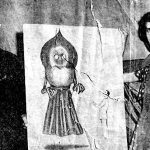Amelia Earhart: The Soaring Spirit of Freedom
Amelia Mary Earhart, one of the most accomplished aviators of the early 20th century, was the first woman to receive the Distinguished Flying Cross and the first to solo-fly across the Atlantic Ocean. Her final flight, an ambitious attempt at circumnavigating the globe, ended with her vanishing into the vast expanse of the Pacific Ocean. Amelia Earhart was not only a legendary figure who shattered the gender constraints in aviation history but also an enigma who disappeared alongside her aircraft, bidding farewell to the world.
Amelia once said, “I knew I had to fly from the moment I felt air under my wings.” For her, the sky was not a limit but a playground where she truly belonged.
Her initial encounter with an airplane occurred when she was just a child, attending an airshow in Toronto with friends. As an aircraft swooped dangerously close, a mix of fear and excitement overwhelmed young Amelia. She later remarked, “At that moment, I didn’t quite understand, but I believed that little red airplane had spoken to me.”
On December 28, 1920, during a 10-minute flight experience in California, Amelia Earhart’s fate was sealed. She decided that she must learn to fly. In less than three years, she became the 16th woman in the world to hold a pilot’s license issued by the Fédération Aéronautique Internationale.
In 1927, Charles Lindbergh made history as the first person to complete a solo nonstop transatlantic flight. In 1928, Amelia, along with two other aviators, flew for 21 hours across the Atlantic. However, she wasn’t entirely satisfied with this experience and candidly admitted, “Stultz did all the flying. He had to. I was just baggage, like a sack of potatoes.” She dropped a hint, saying, “Maybe someday I’ll try it alone.”
While this journey brought her fame, Amelia did not take pride in it. During that era, women’s roles were predominantly passive, and they were often protected like delicate luggage. Female pilots were rarely seen in aviation history, and men usually took the lead.
Five years later, on May 20, 1932, Amelia took control of her destiny. She embarked on a 14-hour, 45-minute flight from Harbor Grace, Newfoundland, to a pasture in Northern Ireland, piloting her beloved “Lockheed Vega” nicknamed “Old Bessie.” With this remarkable flight, she became the first woman to solo-fly across the Atlantic, challenging societal perceptions and paving the way for a future of active pursuit.

In the following years, Amelia never gave up on flying. The sky was where she felt most at home. In 1935, she became the first person to fly solo from Honolulu, Hawaii, to Oakland, California, setting records for speed and distance.
Then came the fateful global flight in 1937. During the first attempt, the aircraft suffered severe damage. In the second attempt, Amelia embarked on the journey with navigator Fred Noonan, flying from Miami to New Guinea and then to Howland Island. However, they lost communication en route, and the last radio contact was on Gardner Island. Amelia Earhart vanished, leaving historians and scholars with one of the greatest mysteries in history.
Amelia Earhart looked up to the sky, conquered it, and eventually disappeared into it. Perhaps, for someone who loved flying as much as she did, this was the greatest fortune. As people gaze at the sky, they remember a woman who once said, “I want to do it because I want to do it,” a woman who defied conformity in the vast expanse of the skies and left an indelible mark among the clouds.
Disappearance on a Global Flight:
Amelia Earhart, a 20th-century legend and the first woman to successfully pilot an aircraft solo across the Atlantic Ocean, mysteriously vanished during her attempt to circumnavigate the globe in 1937. Her whereabouts have remained a subject of worldwide interest. Recently, a significant piece of evidence has surfaced, suggesting that Earhart may have survived a plane crash but was subsequently taken into custody by the Japanese military.
The History Channel, known for its historical documentary broadcasts, unearthed a crucial photograph from an almost-forgotten archive at the U.S. National Archives. The photograph shows a short-haired woman with her back to the camera, believed to be none other than the missing Amelia Earhart. The man on the far left is presumed to be her navigator, 39-year-old Fred Noonan, who also disappeared with her. Furthermore, in the background, one can see an object being towed by a Japanese vessel, believed to be the wreckage of Earhart’s plane.
This photograph is thought to have been taken in 1937 on Jaluit Atoll in the Marshall Islands of the Pacific, and experts have confirmed that it has not been altered. The investigative team believes that this photograph was taken by American spies during their collection of Japanese military intelligence. Former FBI Assistant Director and NBC analyst Shawn Henry firmly believes that this photograph is key evidence indicating that the Japanese took Amelia Earhart into custody.

The Japanese government has responded by stating that there are no records of Amelia Earhart being detained by them. However, The History Channel speculates that Earhart was later taken to Saipan in the Northern Mariana Islands by the Japanese, where she might have been held captive until her eventual fate.
The History Channel concedes that the exact circumstances and time of Amelia Earhart’s fate remain undetermined. The U.S. government officially declared Earhart deceased in 1939, but her remains have never been found.
NBC reports suggest that it remains unclear whether the U.S. government at the time knew the identity of the individuals in the photograph. If the photograph was indeed taken by American spies, it is possible that the U.S. authorities chose to keep the identity confidential to protect espionage activities.
On the other hand, some argue that the U.S. authorities may have kept the secret of Earhart’s capture by the Japanese in order to preserve post-war friendly relations between the United States and Japan.
The Mystery of Amelia Mary Earhart’s Disappearance: Exploring Various Possibilities
Concerning the disappearance of Amelia Mary Earhart, there exist numerous theories and speculations in the public domain. However, to this day, her disappearance remains an enigma, sparking extensive discussions and research. Here are some possibilities and related perspectives:
- Aircraft Malfunction or Fuel Depletion: A common theory suggests that Amelia’s aircraft may have encountered technical issues or run out of fuel during her global flight, necessitating an emergency landing on the ocean or an uninhabited island. However, the primary challenge to this theory is the lack of concrete evidence to support this hypothesis.
- Japanese Military Capture: Recently surfaced photographs have ignited debates about whether Amelia Earhart was captured by the Japanese military. According to this theory, her plane might have inadvertently strayed over the Pacific and was eventually discovered and detained by the Japanese military. However, the Japanese government has denied this claim and has not provided any related evidence.
- Survival on an Uninhabited Island: Another theory posits that Amelia Earhart may have survived on an uninhabited island in the Pacific. Supporters of this theory point to instances where search teams found items or traces that could be linked to Amelia, but this evidence has not been sufficient to confirm whether she ever lived on an uninhabited island.
- Plane Sinking to the Ocean Floor: There is also a theory that suggests Amelia Earhart’s aircraft may have crashed into the deep sea, causing both her and the plane to sink to the ocean floor, making them challenging to locate. The challenge with this possibility lies in the vast expanse of the Pacific Ocean, making search operations exceedingly difficult.
- Ongoing Search and Investigation: With the passage of time, the relevant evidence concerning Amelia Earhart’s disappearance may have deteriorated or become obscured. Nonetheless, advancing technology and new search methods continue to be employed in the hope of eventually unraveling this century-old mystery.
In conclusion, the case of Amelia Mary Earhart’s disappearance remains shrouded in mystery, with various theories and speculations persisting. Despite years of search and research efforts, her ultimate fate remains undetermined. This story is not just a legend; it also symbolizes bravery and adventure, continuing to pique people’s curiosity and encourage them to explore the unknown. Perhaps one day, this mystery will be unraveled, allowing us to gain deeper insight into the final chapter of this aviation legend.

End:
Amelia Mary Earhart, one of the most outstanding aviators of the early 20th century, is renowned for her remarkable achievements. However, her mysterious disappearance in 1937 while attempting to circumnavigate the globe remains an enduring enigma.
Various theories surround her vanishing, including aircraft malfunction, fuel depletion, capture by the Japanese military, or survival on an uninhabited island. Yet, despite extensive searches and research, along with technological advancements, her fate remains unclear.
A recent photograph suggests she may have been detained by the Japanese, but this remains a subject of debate. The mystery of Amelia Mary Earhart’s disappearance is not just a historical puzzle; it also symbolizes courage and adventure. It continues to arouse human curiosity about the unknown and instills a steadfast belief in pushing boundaries. With ongoing exploration, we hope that one day, the destiny of this legendary female aviator, who yearned for the freedom of the open skies, will be unveiled.









